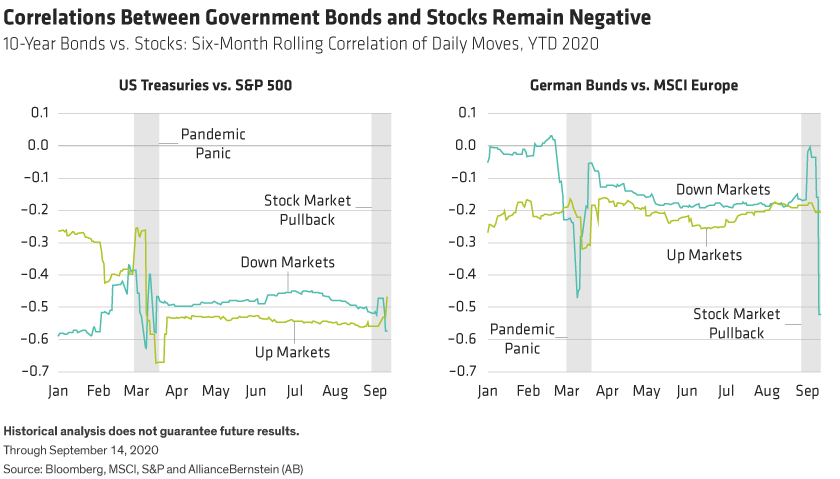by Scott Dimaggio and Gershon Distenfeld, Co-Heads of Fixed Income, AllianceBernstein
Can bonds continue to play defense and provide income when yields are at historic lows? We think so. By strategically pairing interest-rate risk with diverse sources of credit risk, investors can improve the risk, return and income profiles of their portfolios.
Low Yields and High Volatility Will Stick Around
Investors’ concerns are understandable. Central banks have driven interest rates to record lows in an effort to prime an economic recovery during the pandemic. Those low and negative yields could last a long time. In fact, the US Federal Reserve indicated in mid-September that it will peg interest rates near zero through at least 2023.
At the same time, volatility is almost certain to ramp up in the coming months because of a possible second wave of COVID-19 cases; November’s US elections, which could be contested; rising geopolitical tensions and ongoing trade wars; and increasingly adversarial Brexit negotiations.
Under these conditions, a bond portfolio must play both defense and offense. It must limit downside risk in volatile markets, and it must generate income and return despite a low-yield environment. Thankfully, the fixed-income market is still positioned to meet both objectives.
Let’s start with the role of government bonds in limiting downside risk.
US Treasuries and German Bunds Still Play Defense
Some market observers have suggested that low and negative yields will hinder government bonds’ ability to provide a buffer against down markets because bond returns will also be low.
We agree that government bond returns will be more muted than in the past because of low yield levels. Indeed, US Treasury returns have been comparatively muted for the last decade, having already reached the lower limits of a downward trend in yields that lasted 30 years.
However, we believe that the argument linking meaningful returns to risk mitigation misses the mark, for two reasons. First, a long history of extremely low yields in Japan suggests that low yields do not necessarily map to low returns. For 11 of the last 12 years, the yield on the 10-year Japanese government bond was less than 1%. In contrast, returns over the same period rarely matched starting yield levels. Instead, returns averaged more than twice as much as yields, thanks to a price bump as bonds rolled down the steep yield curve.
Second, amid the dramatic sell-off in risk assets earlier this year as the global pandemic took hold, and again in September when equity markets pulled back, government bonds served as one of the few true offsets to equity market volatility (Display 1).

As seen here, the correlation between US Treasuries and the S&P 500 has remained below –0.4 on down days for the stock market, despite a 10-year Treasury yield well below 1%. And in Europe, where yields on 10-year German Bunds were well into negative territory when stock markets fell in March and September, correlations became even more negative during sell-offs.
In other words, government bonds became more defensive when defensiveness was needed most. That argues for an allocation to government bonds as an essential buffer during periods of heightened volatility in the risk markets.
Look to Diverse Sources for Income
Meanwhile, investors’ need for income and return is as great as ever, even as global stock dividends plummet. It’s worth underscoring that bonds are senior to equities in the capital structure and, unlike stocks, must make their coupon payments or be in default. Bonds are thus the only asset class that reliably provides income.
Today, investors should consider diversifying across higher-yielding fixed-income sectors to enhance income and potential return. This approach capitalizes on relative value opportunities while taking advantage of differing correlations among sectors.
For example, today we see opportunities—and attractive yield—in select BBB-rated credits, fallen angels, high-yield corporates, subordinated (AT1) European bank debt, emerging-market debt and securitized assets such as credit–risk transfer (CRT) securities and commercial mortgage-backed securities.
Strike a Balance to Meet Defense and Income Goals
Investors looking to make the most of their bond allocation might consider pairing exposure to government bonds with a mix of higher-yielding sectors in a single portfolio. In contrast with a traditional, benchmark-hugging portfolio, the balanced portfolio targets the desired objectives of defense plus efficient income.
That’s because the two groups are negatively correlated during risk-off environments, much like US Treasuries and stocks. In other words, safety-seeking assets such as government bonds tend to do well when return-seeking assets, such as high-yield corporates, have a down day.
In addition, if managed dynamically, such a portfolio can tilt toward either exposure as market conditions change. For example, today it makes sense to tilt toward credit to enhance income and potential return, while simultaneously preferring long US Treasuries to intermediate-term Treasuries. Long Treasuries tend to provide more cushion in periods of volatility for risk assets.
Further, an active investor can take advantage of opportunities as they arise. For example, some risk assets have rebounded more quickly than others since the pandemic began, and active managers can rotate into lagging sectors before they recover. Spikes in volatility can create windows for snapping up cheaply priced bonds. And depending on the outcome of the US elections later in the year, the energy, tech and basic materials sectors may look more or less attractive. Lastly, it’s important to be selective in today’s uncertain environment. Fundamentals matter.
The Whole Harvest
For many decades, through good years and bad, the bond market has been uniquely able to achieve the seemingly conflicting objectives of mitigating downside risk and sourcing attractive income and potential return.
Today, the landscape seems exceptionally harsh. But we believe that, even in a season of low yields and heightened volatility, investors can still reap the benefits of an actively managed, thoughtfully constructed bond portfolio.
Scott DiMaggio and Gershon Distenfeld are Co-Heads of Fixed Income at AB.
The views expressed herein do not constitute research, investment advice or trade recommendations and do not necessarily represent the views of all AB portfolio-management teams. Views are subject to change over time.
MSCI makes no express or implied warranties or representations and shall have no liability whatsoever with respect to any MSCI data contained herein. The MSCI data may not be further redistributed or used as a basis for other indices or any securities or financial products. This report is not approved, reviewed or produced by MSCI.
This post was first published at the official blog of AllianceBernstein..














